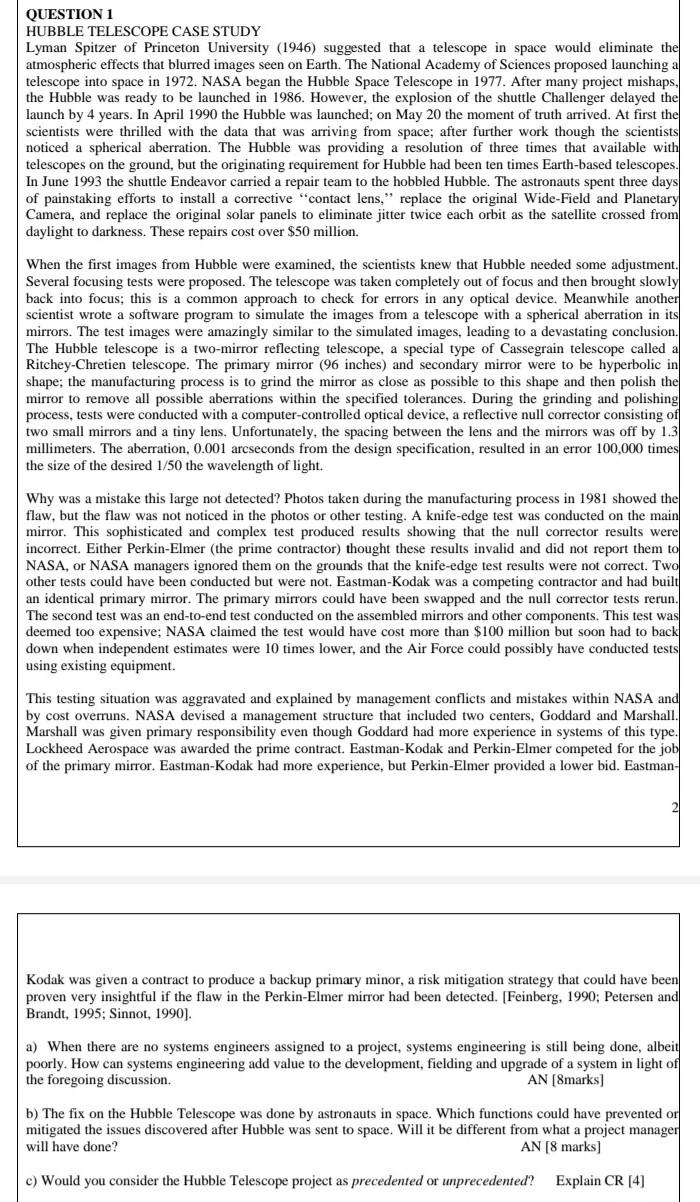Answered step by step
Verified Expert Solution
Question
1 Approved Answer
QUESTION 1 HUBBLE TELESCOPE CASE STUDY Lyman Spitzer of Princeton University (1946) suggested that a telescope in space would eliminate the atmospheric effects that blurred

QUESTION 1 HUBBLE TELESCOPE CASE STUDY Lyman Spitzer of Princeton University (1946) suggested that a telescope in space would eliminate the atmospheric effects that blurred images seen on Earth. The National Academy of Sciences proposed launching a telescope into space in 1972. NASA began the Hubble Space Telescope in 1977. After many project mishaps, the Hubble was ready to be launched in 1986. However, the explosion of the shuttle Challenger delayed the launch by 4 years. In April 1990 the Hubble was launched; on May 20 the moment of truth arrived. At first the scientists were thrilled with the data that was arriving from space; after further work though the scientists noticed a spherical aberration. The Hubble was providing a resolution of three times that available with telescopes on the ground, but the originating requirement for Hubble had been ten times Earth-based telescopes. In June 1993 the shuttle Endeavor carried a repair team to the hobbled Hubble. The astronauts spent three days of painstaking efforts to install a corrective "contact lens," replace the original Wide-Field and Planetary Camera, and replace the original solar panels to eliminate jitter twice each orbit as the satellite crossed from daylight to darkness. These repairs cost over $50 million. When the first images from Hubble were examined, the scientists knew that Hubble needed some adjustment. Several focusing tests were proposed. The telescope was taken completely out of focus and then brought slowly back into focus; this is a common approach to check for errors in any optical device. Meanwhile another scientist wrote a software program to simulate the images from a telescope with a spherical aberration in its mirrors. The test images were amazingly similar to the simulated images, leading to a devastating conclusion. The Hubble telescope is a two-mirror reflecting telescope, a special type of Cassegrain telescope called Ritchey-Chretien telescope. The primary mirror (96 inches) and secondary mirror were to be hyperbolic in shape; the manufacturing process is to grind the mirror as close as possible to this shape and then polish the mirror to remove all possible aberrations within the specified tolerances. During the grinding and polishing process, tests were conducted with a computer-controlled optical device, a reflective null corrector consisting of two small mirrors and a tiny lens. Unfortunately, the spacing between the lens and the mirrors was off by 1.3 millimeters. The aberration, 0.001 arcseconds from the design specification, resulted in an error 100,000 times the size of the desired 1/50 the wavelength of light. Why was a mistake this large not detected? Photos taken during the manufacturing process in 1981 showed the flaw, but the flaw was not noticed in the photos or other testing. A knife-edge test was conducted on the main mirror. This sophisticated and complex test produced results showing that the null corrector results were incorrect. Either Perkin-Elmer (the prime contractor) thought these results invalid and did not report them to NASA, or NASA managers ignored them on the grounds that the knife-edge test results were not correct. Two other tests could have been conducted but were not. Eastman-Kodak was a competing contractor and had built an identical primary mirror. The primary mirrors could have been swapped and the null corrector tests rerun. The second test was an end-to-end test conducted on the assembled mirrors and other components. This test was deemed too expensive; NASA claimed the test would have cost more than $100 million but soon had to back down when independent estimates were 10 times lower, and the Air Force could possibly have conducted tests using existing equipment. This testing situation was aggravated and explained by management conflicts and mistakes within NASA and by cost overruns. NASA devised a management structure that included two centers, Goddard and Marshall. Marshall was given primary responsibility even though Goddard had more experience in systems of this type. Lockheed Aerospace was awarded the prime contract. Eastman-Kodak and Perkin-Elmer competed for the job of the primary mirror. Eastman-Kodak had more experience, Perkin-Elmer provided a lower bid. Eastman- Kodak was given a contract to produce a backup primary minor, a risk mitigation strategy that could have been proven very insightful if the flaw in the Perkin-Elmer mirror had been detected. (Feinberg, 1990; Petersen and Brandt, 1995; Sinnot, 1990). a) When there are no systems engineers assigned to a project, systems engineering is still being done, albeit poorly. How can systems engineering add value to the development, fielding and upgrade of a system in light of the foregoing discussion AN (8marks b) The fix on the Hubble Telescope was done by astronauts in space. Which functions could have prevented or mitigated the issues discovered after Hubble was sent to space. Will it be different from what a project manager will have done? AN (8 marks) c) Would you consider the Hubble Telescope project as precedented or unprecedented? Explain CR [41
Step by Step Solution
There are 3 Steps involved in it
Step: 1

Get Instant Access to Expert-Tailored Solutions
See step-by-step solutions with expert insights and AI powered tools for academic success
Step: 2

Step: 3

Ace Your Homework with AI
Get the answers you need in no time with our AI-driven, step-by-step assistance
Get Started


